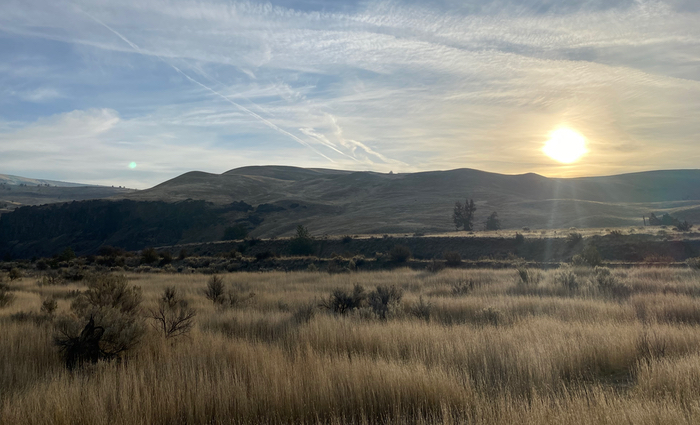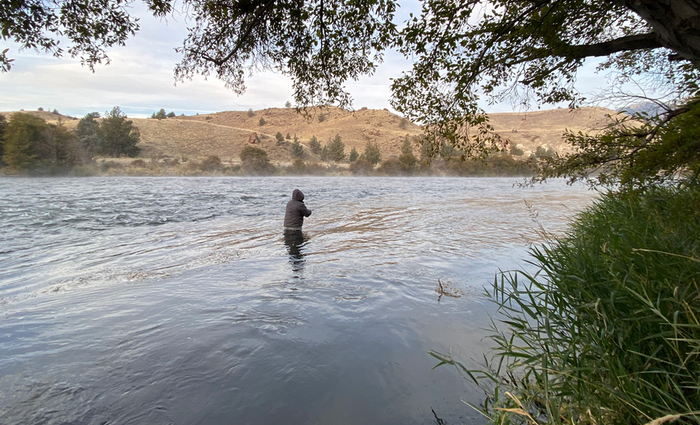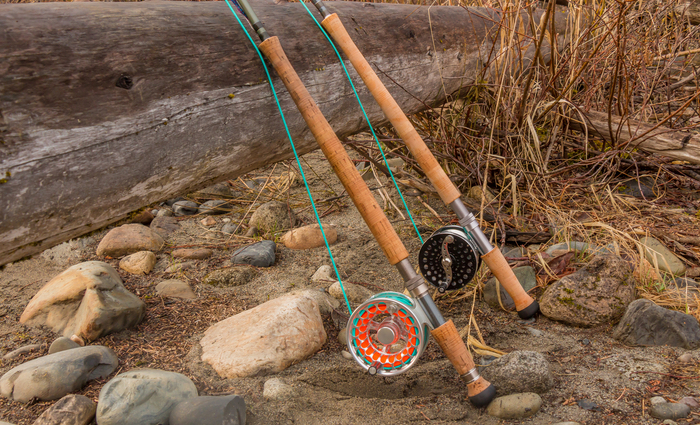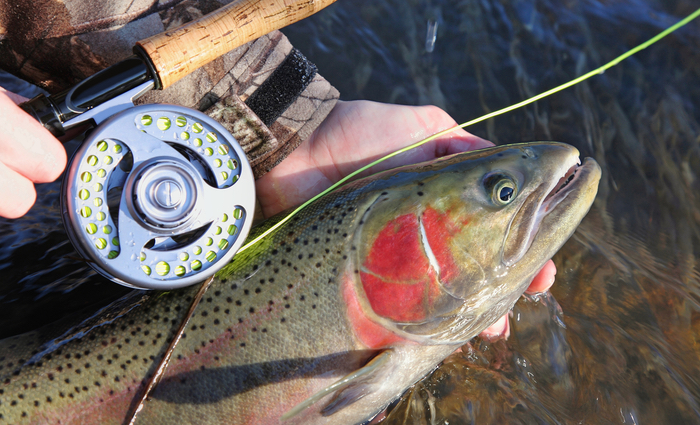Planning a Fly Fishing Trip Lower Deschutes River this summer or fall? Read on to find the best trips and tricks to make your Central Oregon fly fishing adventure a success.
The Lower Deschutes River is one of the premier fly fishing destinations in the United States, offering miles of pristine waterways and stunning scenery. The river originates from Little Lava Lake in the Cascade Mountains and flows into the Columbia River near the city of The Dalles. It is a tributary of the Columbia River and is known for its rugged canyon scenery, clear and cold water, and excellent populations of rainbow trout and steelhead.
Whether you’re an experienced angler or just starting out, a fly fishing trip to the Lower Deschutes River is an adventure you won’t soon forget. From the thrill of catching trophy trout to the challenge of hooking steelhead, the Lower Deschutes River has something for every fly fisherman.
In this article, we’ll share everything you need to know to plan your own unforgettable fly-fishing trip on the Lower Deschutes River.
Planning a Fly Fishing Trip Lower Deschutes River-Trout
The Lower Deschutes River is a world-class trout fishery, known for its healthy populations of native red band rainbow trout. Trout season on the Lower Deschutes typically runs year-round, with the best fishing occurring during the spring and fall months. Here are some key things to know about trout fishing on the Lower Deschutes River:
Hatches: The Lower Deschutes River has a variety of aquatic insects that hatch throughout the year, including mayflies, caddisflies, and stoneflies. The famous salmon fly hatch occurs in May and June, which is a prime time to target large rainbow trout on dry flies.
Techniques: Trout on the Lower Deschutes can be caught on a variety of techniques, including dry flies, nymphs, and streamers. Fishing dry flies can be particularly productive during hatches, while nymphing is a good choice when there is no surface-feeding fish.
Access points: The Lower Deschutes River has many access points along its length, making it a popular destination for DIY trout fishing. However, some areas of the river are only accessible by boat, so be sure to research access points before your trip.
Regulations: The Lower Deschutes River has specific regulations for trout fishing, including catch-and-release only in some areas, and artificial fly and lure only in others. Be sure to check the current regulations before fishing to ensure compliance.
Trout fishing on the Lower Deschutes River is a unique and rewarding experience, and with careful planning and preparation, anglers can have a successful trip targeting these beautiful fish. Follow Lower Deschutes Trout Trips for more information.
Lower Deschutes River-Fishing Regulations
I-84 bridge to Sherars Falls
Open all year for trout and hatchery steelhead.
2 rainbow trout per day, 10-inch minimum and 13-inch maximum length.
Open for Chinook salmon Aug 1 – Oct 31.
Open for coho salmon Aug 1 – Dec 31.
No limit on size or number of bass.
Bait allowed only from Sherars Falls downstream to upper trestle (approx. 3 Mi).
No angling from a floating device.
Closed from Sherars Falls downstream to Buck Hollow Cr (approx. 1 Mi) Apr 1 – Jul 31.
Sherars Falls to Northern Boundary of the Warm Springs Reservation (including White River upstream to first falls)
Open all year for trout and hatchery steelhead.
2 rainbow trout per day, 10 inch minimum and 13 inch maximum length.
Open for coho salmon Aug 1 – Dec 31.
No limit on size or number of bass.
No angling from a floating device.
Northern Boundary of the Warm Springs Reservation to the Pelton Regulating Reservoir.
Open Apr 22 – Dec 31 for trout and hatchery steelhead.
2 rainbow trout per day, 10 inch minimum and 13 inch maximum length.
Open for coho salmon Aug 1 – Dec 31.
No limit on size or number of bass.
No angling from a floating device.
See Lake Simtustus.
Closed from Pelton Regulating Dam downstream approx. 600 ft to ODFW markers.

Planning a Fly Fishing Trip Lower Deschutes River-Steelhead
The Lower Deschutes River is also a popular destination for steelhead fishing, with runs of these prized game fish occurring from July through December. Here are some essential things to know about steelhead fishing on the Lower Deschutes River:
Steelhead behavior: Steelhead is migratory fish that spend most of their lives in the ocean, but return to freshwater rivers to spawn. They are known for their hard-fighting nature and acrobatic jumps, making them a thrilling target for fly anglers.
Techniques: Steelhead on the Lower Deschutes can be caught on a variety of fly fishing techniques, including swinging flies, nymphing, and skating dry flies. The best technique can vary depending on water conditions and the time of day, so it’s important to be flexible and adaptable.
Access points: Like trout fishing, steelhead fishing on the Lower Deschutes can be done both by boat and on foot. However, some of the best steelhead runs are located in areas that are only accessible by boat, so hiring a guide or owning a boat can increase your chances of success.
Regulations: The Lower Deschutes River has specific regulations for steelhead fishing, including catch-and-release only in some areas, and a limit of one fish per day in others. Be sure to check the current regulations before fishing to ensure compliance.
Steelhead fishing on the Lower Deschutes River is a challenging and rewarding experience and requires a high level of skill and patience. However, with the right technique and equipment, anglers can have a chance at catching one of these elusive game fish. Follow Lower Deschutes Steelhead Trips for more information.

What is the Best Time of Year to Fish the Deschutes River?
The best time of year to fish the Deschutes River depends on what species of fish you are targeting and your personal preferences. Here are some general guidelines for fishing the Deschutes River throughout the year:
Spring: Spring can be an excellent time to target trout on the Lower Deschutes River, as hatches of mayflies, caddisflies, and stoneflies are common. The famous salmon fly hatch usually occurs in May and June, making it a popular time for fly anglers. Spring can also be a good time to target steelhead, as the early run usually begins in late summer.
Summer: Summer can be a challenging time to fish the Deschutes River, as water temperatures can become too warm for trout and steelhead. However, early mornings and evenings can still provide good fishing opportunities.
Fall: Fall is another great time to fish the Deschutes River, as the weather cools down and steelhead runs increase. Trout can also be targeted throughout the fall, with hatches of blue-winged olive mayflies and October caddisflies providing good dry fly opportunities.
Winter: Winter can be a difficult time to fish the Deschutes River, as colder water temperatures can make fishing challenging. However, steelhead runs continue throughout the winter, and some anglers prefer the solitude of winter fishing.
Ultimately, the best time of year to fish the Deschutes River depends on your personal preferences and what species of fish you are targeting. With some research and planning, anglers can find good fishing opportunities on the river throughout the year.

Where can I fly fish in the Deschutes River?
Deschutes River is a great destination for fly fishing enthusiasts, offering miles of prime fishing spots for anglers of all levels. Here are some of the best places to fly fish in the Deschutes River:
Lower Deschutes River: This section of the river is known for its wild trout population and scenic beauty. Anglers can expect to catch trout, steelhead, and salmon during certain seasons.
Maupin Area: Located in the middle section of the river, the Maupin area is popular for its large rainbow trout and steelhead. The area is easily accessible and offers a variety of fishing opportunities.
Warm Springs Area: This section of the river is known for its native reside rainbow trout, which can be caught using dry flies and nymphs. Anglers can also catch steelhead and smallmouth bass in this area.
Upper Deschutes River: The upper section of the river is a great spot for anglers looking for a more remote fishing experience. This area is home to native brook trout and also has populations of rainbow and brown trout.
Overall, Deschutes River is a must-visit destination for any fly fishing enthusiast. With its scenic beauty and abundance of fish, there’s no shortage of opportunities to test your skills and enjoy the great outdoors. Follow the complete guide to fly fishing the Deschutes River for more information.

How to Plan a Fly Fishing Trip on the Deschutes River
Planning a fly fishing trip to the Deschutes River can be an exciting and rewarding experience. Here are some key steps to help you plan your trip:
- Determine your budget: Fly fishing trips can vary greatly in cost, depending on factors like transportation, lodging, guides, and equipment. Setting a budget can help you determine what type of trip you can afford.
- Choose your dates: Once you have a budget in mind, choose the dates for your trip. Consider factors like weather, water conditions, and peak fishing times for the species you want to target.
- Choose your accommodations: The Deschutes River offers a range of lodging options, from camping to luxurious lodges. Consider your budget and personal preferences when choosing your accommodations.
- Hire a guide: Hiring a guide can be a great way to improve your chances of success on the river, especially if you are new to fly fishing or unfamiliar with the area.
- Choose your equipment: Depending on your level of experience and the species you want to target, you may need to bring or rent fly fishing equipment. Research the type of gear you need and make sure you are prepared before your trip.
- Plan your itinerary: Once you have all the logistics in place, plan your itinerary for the trip. Consider factors like travel time, fishing locations, and other activities you want to do while in the area.
By following these steps, you can plan a successful and enjoyable fly-fishing trip on the Deschutes River. Remember to do your research, be flexible, and enjoy the experience of fishing in one of the most beautiful rivers in the Pacific Northwest.
Conclusion
The Lower Deschutes River is an unparalleled fly fishing destination that any angler, whether a novice or a pro, should have on their bucket list. The river’s pristine waterways and magnificent scenery offer something for everyone, from the thrill of catching trophy trout to the challenge of hooking steelhead. By following the guidelines we have shared in this comprehensive guide, you can have a successful and unforgettable fly-fishing trip on the Lower Deschutes River.
Whether you’re targeting trout or steelhead, it’s important to remember that fishing on this river is not just about catching fish but also about immersing yourself in the beauty of nature and connecting with your inner self. So pack your gear, head to the Lower Deschutes River, and get ready for an adventure of a lifetime! Follow Deschutes River Fly Fishing Guides for more information.
